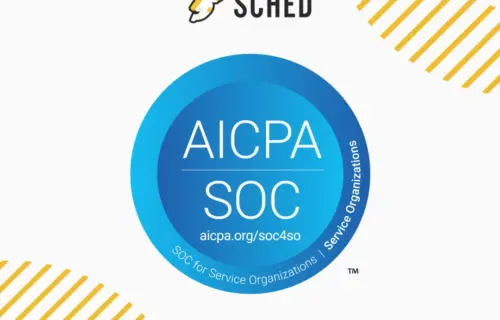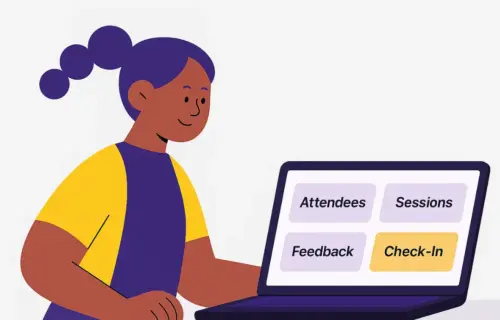Planning school events isn’t just logistics. You need to create meaningful experiences that support learning, strengthen school culture, and build trust with staff, families, and the community.
But even the most well-intentioned teams can fall into traps that derail the experience and drain everyone’s energy.
Below are 20 common (and costly) planning mistakes schools make and how to avoid them.
20 Mistakes School Event Planners Regret (and How to Avoid Them)
Table of contents
- 1 20 Mistakes School Event Planners Regret (and How to Avoid Them)
- 1.1 1. Planning Without a Clear Goal
- 1.2 2. Underestimating the Time It Takes to Plan Well
- 1.3 3. Relying on Too Many Disconnected Tools
- 1.4 4. Skipping Personalized Schedules
- 1.5 5. Not Setting Session Capacities
- 1.6 6. Assuming Everyone Will Read the Same Email
- 1.7 7. Ignoring Mobile Access
- 1.8 8. No Real Check-In Process
- 1.9 9. Sending Post-Event Surveys Too Late
- 1.10 10. Using Attendance as the Only Success Metric
- 1.11 11. Overloading the Agenda
- 1.12 12. Failing to Plan for Setup and Transitions
- 1.13 13. Leaving Volunteers or Support Staff Out of the Loop
- 1.14 14. No “Plan B” for Technology
- 1.15 15. Planning in Isolation
- 1.16 16. Forgetting About Accessibility
- 1.17 17. Not Reviewing Event Data Post-Event
- 1.18 18. Assuming People Will “Figure It Out”
- 1.19 19. Letting One Bad Year Set the Tone
- 1.20 20. Trying to Be the System
- 2 The Bottom Line: Event Planning Shouldn’t Be This Hard
1. Planning Without a Clear Goal
Many events are launched because they’re expected, not because their purpose is clearly defined. When goals are vague, sessions feel disconnected, feedback is scattered, and it’s hard to evaluate success after the fact.
Without shared objectives, even a well-run event can fall flat or feel like a waste of time to attendees. And when it’s time to report value back to leadership, there’s no story to tell.
To avoid this, define the “why” before the “how.” Every school event should map to a goal, whether it’s teacher development, family engagement, or community transparency.
Sched helps school event planners organize sessions by track, topic, or role, so staff and leadership can clearly see how each session ties back to specific goals.
2. Underestimating the Time It Takes to Plan Well
School events often start small and grow quickly; PD sessions multiply, rooms get reassigned, and new presenters pop up. If you don’t have a solid planning workflow, the work will overwhelm your time and your team.
Time crunches lead to mistakes; overbooked rooms, missing materials, and unclear agendas. They also burn out the same few people who always “own the plan.”
Factor in planning time like it is instruction time: essential and protected. Use collaborative tools so tasks can be shared, not siloed.
Sched gives teams a shared platform, collaborative roles, and flexible admin tools so you can divide the work and plan faster without drowning in details.
3. Relying on Too Many Disconnected Tools
Google Forms, PDFs, spreadsheets, and inbox threads might get you through one event, but over time, they become brittle. The more moving pieces you have, the more likely something gets missed.
When info lives in five places, nobody knows which is right. Confusion frustrates attendees and creates friction for staff already stretched thin.
Consolidate wherever possible. Centralizing registration, scheduling, check-ins, and feedback in one place removes a huge layer of stress and risk.
Sched helps you consolidate your entire event workflow into one platform: registration, schedule building, check-ins, communications, and reporting. Less chaos, more confidence.
4. Skipping Personalized Schedules
If everyone receives the same flat agenda or paper schedule, you’re forcing them to interpret, sort, and guess what applies to them.
Staff may show up late, miss sessions, or disengage altogether. Families may skip important sessions because they can’t find what matters to them.
Provide attendees with schedules that reflect their role, selections, or grade level. Personalized info reduces cognitive load and increases engagement.
With Sched, attendees can build and view their own personalized schedules, updated in real time across desktop and mobile.
5. Not Setting Session Capacities
A packed room might feel like a win, but not when people are standing, late, or turned away. Worse, overbooking leads to lost instructional time and safety concerns.
If session capacity isn’t managed, it creates confusion and tension for facilitators and attendees alike.
Make sure you set realistic session capacities early. Let the system enforce limits and offer waitlists to keep things fair and calm.
Sched lets you set and enforce session limits automatically, with waitlists and capacity visibility baked into the system.
6. Assuming Everyone Will Read the Same Email
The “we sent an email” approach to communication assumes every attendee opens, reads, and remembers it. Spoiler: they don’t.
Important details get lost in inboxes. That leads to missed sessions, late arrivals, and hallway chaos.
Use layered communication; email, mobile notifications, and a living event hub to make critical info accessible and timely.
Sched lets you send real-time updates and schedule changes via mobile and web, not just email. If someone leaves their phone in a room, you can send a quick push notification to everyone. When plans shift, attendees actually see it.
7. Ignoring Mobile Access
Too many schools still rely on printed agendas or desktop-only access. But most attendees rely on their phones, especially at family events, evening sessions, or multi-campus trainings.
If your event info isn’t accessible on mobile, people default to texting staff, showing up confused, or skipping sessions altogether.
Use a mobile-friendly schedule that updates in real time. If it’s not easy to check on the go, it won’t be used.
Sched offers a fully mobile-optimized event experience. Attendees can view their schedule, check for changes, and navigate the event from their phones.
8. No Real Check-In Process
You know who registered. But do you know who actually showed up? And where?
Without real-time attendance tracking, you can’t measure engagement, meet compliance requirements, or justify investments.
Here’s how to avoid this mistake: Build a lightweight check-in system into the event itself, QR codes, badges, or self-check-in tools can do the trick.
Sched supports check-in via QR code, self check-in, and manual tracking, all tied to sessions. No clipboards. No guesswork. No manual reconciliation.
9. Sending Post-Event Surveys Too Late
Sending feedback surveys days later? That’s too late. People forget, priorities shift, and responses trickle in, or don’t come at all.
Low response rates = low-quality data. That makes it hard to know what worked or justify what comes next.
Collect session-level feedback while attendees are still in the flow, right after the session ends, not days later.
Sched collects feedback right after sessions end, when it’s still fresh. That means better insights and higher response rates without needing a separate survey tool.
10. Using Attendance as the Only Success Metric
Headcounts are helpful, but they’re just the start. Did attendees enjoy the sessions? Learn something? Want to come back?
Without context, leadership can’t connect events to outcomes like retention, satisfaction, or PD quality. You may be investing heavily in events that check a box but don’t drive growth, connection, or improvement.
Combine attendance with satisfaction data and engagement trends to build a more accurate picture of success.
Sched combines attendance data with session ratings, feedback, and trends, so you can show value, not just turnout.
11. Overloading the Agenda
Packing the day with back-to-back sessions might look impressive, but it often backfires. People tune out, burn out, or disengage.
Overwhelmed staff retain less and rate events poorly, even if the content is strong.
Build in breaks, reflection time, and opportunities to choose. Respect your attendees’ bandwidth.
Sched makes it easy to build balanced agendas with intentional breaks, reflection blocks, and variety, without spreadsheet gymnastics.
12. Failing to Plan for Setup and Transitions
Session blocks might look great on paper, but if there’s no time to reset rooms, test AV, or move between buildings, things quickly fall apart.
A tight schedule with no transition time causes delays that ripple across the entire event. Make sure you’re scheduling transition buffers like you would sessions. Build a timeline that includes the invisible work.
With Sched’s flexible schedule builder, you can build in setup and transition windows, so your event runs on time and stress-free.
13. Leaving Volunteers or Support Staff Out of the Loop
Your greeters, check-in helpers, and tech crew are essential, but often, they’re the last to know when plans change.
When your frontline support is out of sync, attendees feel it through long lines, unclear directions, or awkward gaps.
Give volunteers access to real-time schedules and updates. Empower them to solve problems, not just escalate them.
Sched gives you the ability to share live schedules and role-specific visibility with anyone on your team, so everyone’s aligned in real time.
14. No “Plan B” for Technology
If everything lives in one spreadsheet or behind one login, your entire event is vulnerable to Wi-Fi outages, device issues, or simple human error.
Tech failure = frustration. And for public-facing events, that reflects poorly on your school or district. It also wastes the valuable time of your IT department.
Choose tools with offline access, mobile options, and flexible backup plans.
Sched offers mobile access, offline schedule views, and multiple admin roles, so your plan doesn’t go down if one device does.
15. Planning in Isolation
Too many school event leads carry the weight alone because they don’t have a system that makes sharing easy or safe.
Solo planning leads to burnout, bottlenecks, and missed opportunities for creativity and input.
A better approach? Distribute the work. Use collaborative planning tools so your event isn’t dependent on a single hero.
Sched supports role-based permissions, so you can assign tasks, delegate ownership, and collaborate without compromising control.
16. Forgetting About Accessibility
Digital equity matters. If your event experience isn’t mobile-friendly, ADA-compliant, or easy to navigate for all participants, some voices will be left out.
Inaccessible events impact trust, participation, and community reputation, especially among families and support staff.
Ensure your schedule and event content are accessible across devices and formats. Use platforms that support ADA compliance and mobile-first design.
Sched’s platform is designed to be accessible across devices and screen sizes, with clean layouts and thoughtful UX for all attendees.
17. Not Reviewing Event Data Post-Event
If you don’t reflect on how the event went, you’re planning blind next time. Many schools move on too fast, losing insights they’ve already earned.
You can’t improve what you don’t measure. And without post-event analysis, patterns and opportunities go unnoticed.
Block time after every major event for review. Look at attendance patterns, session feedback, and capacity issues to guide future planning.
With Sched’s built-in reporting dashboard, you can review attendance trends, feedback summaries, and engagement stats in minutes.
18. Assuming People Will “Figure It Out”
When session titles are vague, signage is lacking, or updates don’t reach people, you’re asking attendees to navigate chaos.
Confusion creates stress and makes even great content feel frustrating.
Ensure you over-communicate with clarity. Use tools that make the event experience intuitive and self-guided.
Sched gives attendees a centralized event hub with clear session details, real-time updates, and search features that remove the guesswork.
19. Letting One Bad Year Set the Tone
If one chaotic or poorly-attended event breaks trust, it’s hard to win people back even if your team has improved behind the scenes.
Perception matters. Without a better experience next time, participation drops and morale takes a hit.
Acknowledge past challenges, and show how things are changing. Use consistent systems, better planning workflows, and clearer communication.
20. Trying to Be the System
Too often, one person becomes the entire event infrastructure: fielding questions, updating schedules, sending emails, tracking attendance.
That leads to burnout, bottlenecks, and inconsistent execution.
Let your systems do the work. Choose an event platform that handles logistics, not just collects data. Focus your energy on strategy, not spreadsheets.
Sched becomes your system. It handles registration, sign-ups, communications, analytics, and more, so planners can focus on strategy, not spreadsheets.
The Bottom Line: Event Planning Shouldn’t Be This Hard
Whether you’re planning a districtwide PD day, a family literacy night, or a multi-campus summit, you shouldn’t have to reinvent the wheel, or drown in it.
The common thread across these 20 mistakes? They’re all preventable with the right process and platform.
With clearer goals, stronger collaboration, and better tools, schools can plan events that are:
- Easier to run.
- More engaging for staff and families.
- Easier to measure and improve.
- Aligned with district goals and outcomes.
Sched’s event management platform was built for exactly this kind of work; helping K–12 teams streamline their planning, reduce stress, and focus on what matters. With Sched, you can create meaningful events that build culture and connection.
Want to Avoid These Mistakes In Your Next Event?
Start your free trial of Sched and explore how it can support your school’s events, from PD to parent nights. No credit card required. Just clarity from the start.








